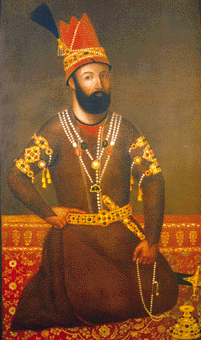1729 - 1747 :
Nader Shah Afshar, an officer of the Safavids, was able to expel the Afghans and reunite the country.
Acting in behalf of the defeated Safavids, he expelled the Afghans in 1729, and in 1732 became regent. The following year he forced the Ottoman Turks out of Mesopotamia, which they had seized during the Afghan invasion, and induced the Russians to give up Iranian territory they had occupied. In 1736 he took the Iranian throne for himself as Nader Shah. By 1738 he had conquered Afghanistan, and in 1739 he invaded northern India, capturing Delhi, the capital of the Mughal Empire. In his invasion of Mughal India, Nader Shah captured two of the world's greatest diamonds, the Sea of Light (now in Iran) and the Mountain of Light (now part of the British Crown Jewels).
He soon extended his rule into what is now Western Turkistan. Nader Shah's victories made him briefly the Middle East's most powerful sovereign.
|

Nader Shah
|
 previous dynasty
previous dynasty


 previous dynasty
previous dynasty
